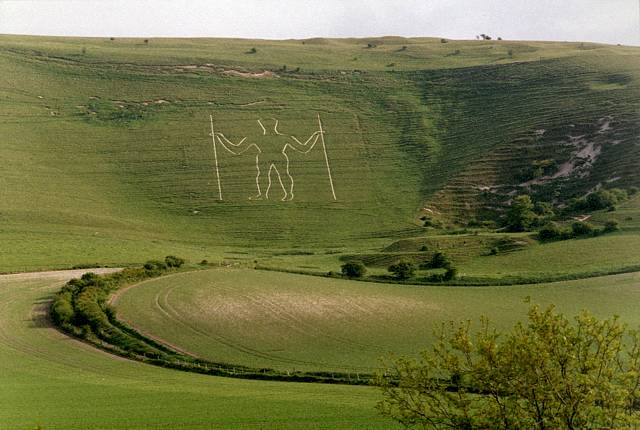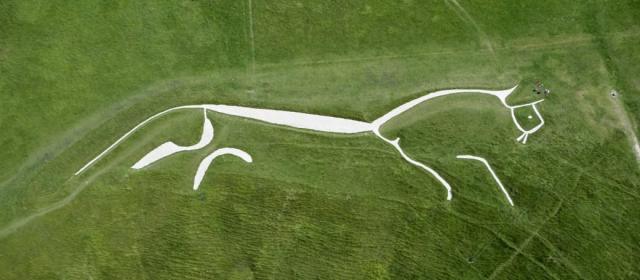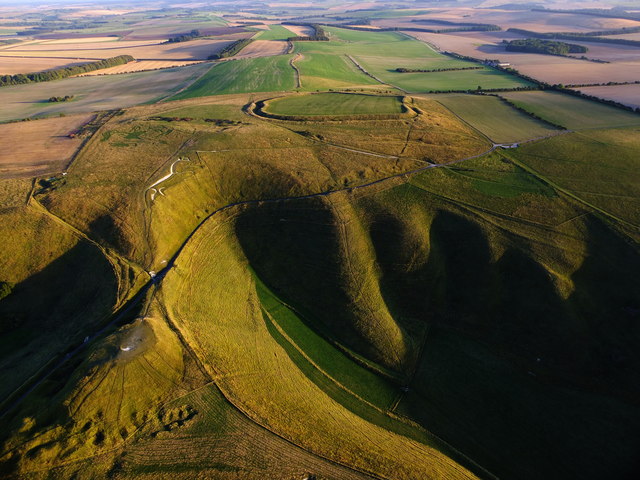The chalk hills of old England have had figures cut into them for millennia. Some of these have faded back into the hills others have been recut regularly in order to preserve them.
The Cerne Abbas Giant is carved into the green turf of a steep hill near the village of Cerne Abbas in Dorset. He stands proud at 55m tall holding a club in his right hand. His left hand may also have held a cloak or a dismembered head at some point.
Local legend is that he was a real giant who caused havoc in the area smashing up houses & eating sheep. One day he lay down on the hill to digest his meal & the locals set on him & killed him in his sleep. They then carved out his outline in chalk. This folktale makes no mention of the giant erect penis.
In 1774 in the History of Dorset by John Hutchins this is said of the giant, “I have heard from the steward of the manor that it is a modern thing cut out in Lord Hollis’ time” This dates to between 1641 & 1666. However Lord Hollis may have only recut the figure. In the Churchwardens’ accounts from St Mary’s Church in Cerne Abbas there is an entry for 1694; “for repairing ye giant, 3 shillings”
The earliest known drawing of the Giant appears in the August 1764 issue of Gentleman’s Magazine. By the Victorian period (after 1837) the penis was removed from academic and tourist depictions.
There are several ideas concerning the age of the Giant, and whom he might represent:
One theory is that because there is no medieval documentary evidence, then the Giant was created in the 17th century, perhaps by Lord Holles, who resided in Cerne Abbas, and perhaps as a parody of Oliver Cromwell.
Another is that the Giant dates to the time of the Romans in Britain (i.e. Romano-British), because the Giant resembles the Roman god Hercules, who was based on the Greek god Heracles.
Yet another is that the Giant is of Pagan Celtic origin, because it is stylistically similar to a Celtic god on a skillet handle found at Hod Hill, Dorset, and dated to around AD 10 to AD 51 & of Northern European depictions of gods of the time.
Since Victorian times there has been documented folklore about fertility rituals associated with the giant.
There is a small iron age earthwork on top of Trendle Hill & locals would erect a maypole in the earthwork around which childless couples would dance on May Day in order to promote fertility. The May Pole is a phallic symbol.
Barren women would sit on the giant in the hope of becoming pregnant. The folklore I heard when growing up in Dorset was that if you had intercourse within the penis outline a pregnancy would occur.
In 1921 Walter Long of Gillingham, Dorset objected to the giant’s nudity and conducted a campaign to either convert it to a simple nude, or to cover its supposed obscenity with a leaf. Long’s protest gained some support, including that of two bishops, and eventually reached the Home Office. The Home Office considered the protest to be in humour, though the chief constable responded to say the office could not act against a protected scheduled monument.

Cut into the northern slope of Windover Hill, at the eastern end of the South Downs near Wilmington in Sussex is a giant carrying a long staff in either hand. He is 70m tall. Close to the Long Man are a collection of burial mounds including a long barrow.
He has been variously identified as a local giant, St Paul, a Roman soldier, a Saxon haymaker or as a prehistoric surveyor, or dodman, who used his two staffs as sighting poles. Alfred Watkins came up with the dodman theory. During neolithic times the figure may have been aligned to mark the movement of the constellation Orion over the hill behind it. So he may have been a manifestation of Neolithic astral religion.
The origin is unclear. Up until recently he was thought to have been a neolithic creation as part of the ritual landscape of burial mounds.
More recent surveys have dated the figure to the 16th or 17th century possibly after there was a period of geological instability on the hill.
This is speculation on my part, but I am of the opinion that both the Cerne Abbas & Wilmington Giants are likely to have been older then early modern period based on the style of the figures.

The huge stylised drawing of the White Horse near Uffington in Oxfordshire is dated to between 1740 & 210 BC. It is 110 metres from head to tail & was probably carved by Iron Age Celts. There is an Iron Age hill fort on top of the hill.

The steep sided dry valley below the horse is known as the Manger and legend says that the horse grazes there at night.
Other prominent prehistoric sites are located nearby, notably Wayland’s Smithy, a long barrow less than a mile to the west.
Does this constitute a ritual landscape?
The horse was venerated in Celtic times & may have represented the horse goddess Epona. It may have been a tribal territory marker; the Vale of the White Horse falls at a point where three Celtic tribal zones met.
According to local tradition the horse may actually be a dragon. Close to the horse is Dragon Hill where St George is said to have killed the dragon. No grass grows on the top of the hill where the fabled beast bled out.
Chalk horses & figures stride across the landscape of England & Scotland & we can see them from far away. Some are lost to the hills & forgotten but maybe a sense memory in Plymouth or Gag Magog leaves a faint imprint.
The 5th song on the upcoming Cunning Folk Album is called Chalk Horses…